Jiwen Lu
Terra: Explorable Native 3D World Model with Point Latents
Oct 16, 2025Abstract:World models have garnered increasing attention for comprehensive modeling of the real world. However, most existing methods still rely on pixel-aligned representations as the basis for world evolution, neglecting the inherent 3D nature of the physical world. This could undermine the 3D consistency and diminish the modeling efficiency of world models. In this paper, we present Terra, a native 3D world model that represents and generates explorable environments in an intrinsic 3D latent space. Specifically, we propose a novel point-to-Gaussian variational autoencoder (P2G-VAE) that encodes 3D inputs into a latent point representation, which is subsequently decoded as 3D Gaussian primitives to jointly model geometry and appearance. We then introduce a sparse point flow matching network (SPFlow) for generating the latent point representation, which simultaneously denoises the positions and features of the point latents. Our Terra enables exact multi-view consistency with native 3D representation and architecture, and supports flexible rendering from any viewpoint with only a single generation process. Furthermore, Terra achieves explorable world modeling through progressive generation in the point latent space. We conduct extensive experiments on the challenging indoor scenes from ScanNet v2. Terra achieves state-of-the-art performance in both reconstruction and generation with high 3D consistency.
Pseudo Depth Meets Gaussian: A Feed-forward RGB SLAM Baseline
Aug 06, 2025Abstract:Incrementally recovering real-sized 3D geometry from a pose-free RGB stream is a challenging task in 3D reconstruction, requiring minimal assumptions on input data. Existing methods can be broadly categorized into end-to-end and visual SLAM-based approaches, both of which either struggle with long sequences or depend on slow test-time optimization and depth sensors. To address this, we first integrate a depth estimator into an RGB-D SLAM system, but this approach is hindered by inaccurate geometric details in predicted depth. Through further investigation, we find that 3D Gaussian mapping can effectively solve this problem. Building on this, we propose an online 3D reconstruction method using 3D Gaussian-based SLAM, combined with a feed-forward recurrent prediction module to directly infer camera pose from optical flow. This approach replaces slow test-time optimization with fast network inference, significantly improving tracking speed. Additionally, we introduce a local graph rendering technique to enhance robustness in feed-forward pose prediction. Experimental results on the Replica and TUM-RGBD datasets, along with a real-world deployment demonstration, show that our method achieves performance on par with the state-of-the-art SplaTAM, while reducing tracking time by more than 90\%.
IGL-Nav: Incremental 3D Gaussian Localization for Image-goal Navigation
Aug 01, 2025



Abstract:Visual navigation with an image as goal is a fundamental and challenging problem. Conventional methods either rely on end-to-end RL learning or modular-based policy with topological graph or BEV map as memory, which cannot fully model the geometric relationship between the explored 3D environment and the goal image. In order to efficiently and accurately localize the goal image in 3D space, we build our navigation system upon the renderable 3D gaussian (3DGS) representation. However, due to the computational intensity of 3DGS optimization and the large search space of 6-DoF camera pose, directly leveraging 3DGS for image localization during agent exploration process is prohibitively inefficient. To this end, we propose IGL-Nav, an Incremental 3D Gaussian Localization framework for efficient and 3D-aware image-goal navigation. Specifically, we incrementally update the scene representation as new images arrive with feed-forward monocular prediction. Then we coarsely localize the goal by leveraging the geometric information for discrete space matching, which can be equivalent to efficient 3D convolution. When the agent is close to the goal, we finally solve the fine target pose with optimization via differentiable rendering. The proposed IGL-Nav outperforms existing state-of-the-art methods by a large margin across diverse experimental configurations. It can also handle the more challenging free-view image-goal setting and be deployed on real-world robotic platform using a cellphone to capture goal image at arbitrary pose. Project page: https://gwxuan.github.io/IGL-Nav/.
Streaming 4D Visual Geometry Transformer
Jul 15, 2025

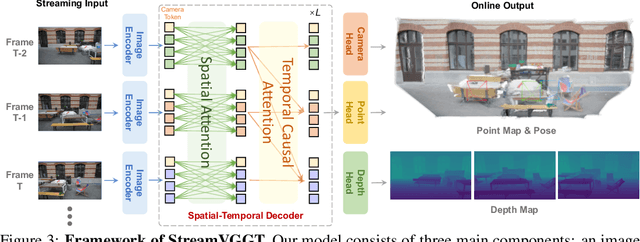

Abstract:Perceiving and reconstructing 4D spatial-temporal geometry from videos is a fundamental yet challenging computer vision task. To facilitate interactive and real-time applications, we propose a streaming 4D visual geometry transformer that shares a similar philosophy with autoregressive large language models. We explore a simple and efficient design and employ a causal transformer architecture to process the input sequence in an online manner. We use temporal causal attention and cache the historical keys and values as implicit memory to enable efficient streaming long-term 4D reconstruction. This design can handle real-time 4D reconstruction by incrementally integrating historical information while maintaining high-quality spatial consistency. For efficient training, we propose to distill knowledge from the dense bidirectional visual geometry grounded transformer (VGGT) to our causal model. For inference, our model supports the migration of optimized efficient attention operator (e.g., FlashAttention) from the field of large language models. Extensive experiments on various 4D geometry perception benchmarks demonstrate that our model increases the inference speed in online scenarios while maintaining competitive performance, paving the way for scalable and interactive 4D vision systems. Code is available at: https://github.com/wzzheng/StreamVGGT.
Ambiguity-aware Point Cloud Segmentation by Adaptive Margin Contrastive Learning
Jul 09, 2025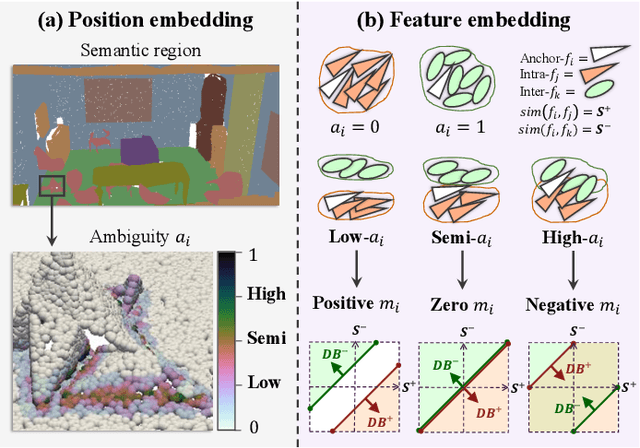
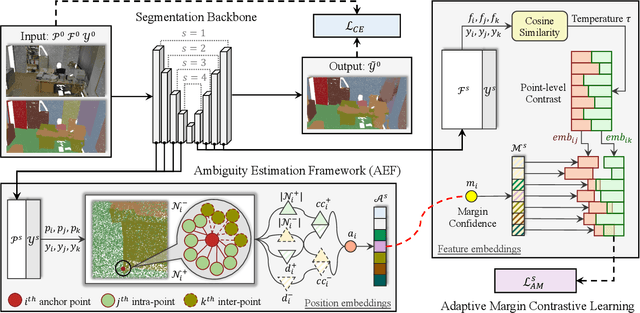
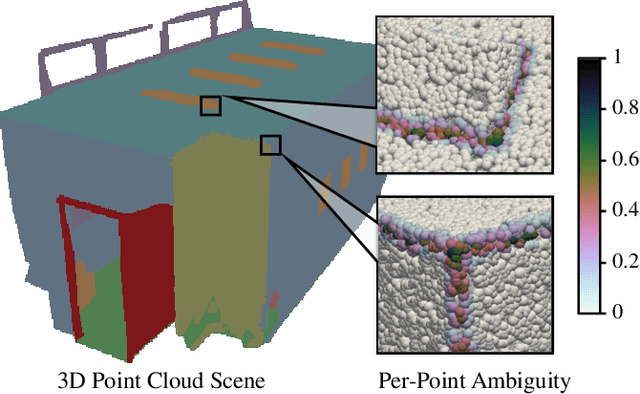
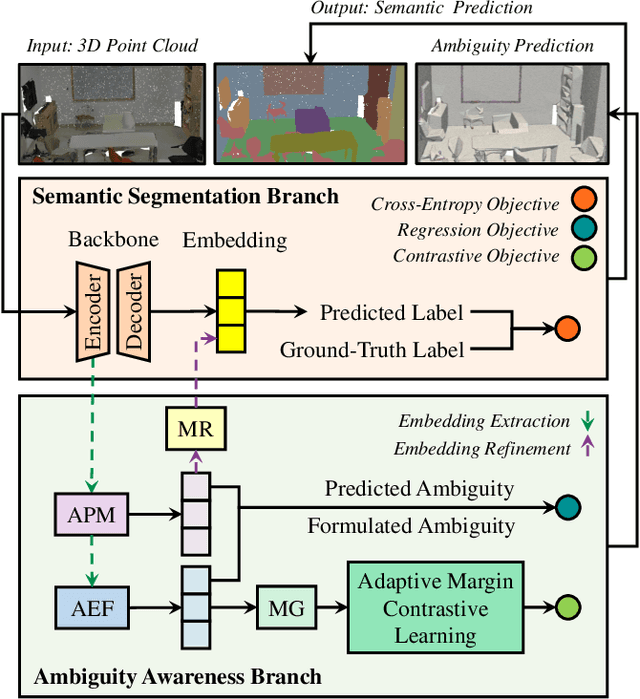
Abstract:This paper proposes an adaptive margin contrastive learning method for 3D semantic segmentation on point clouds. Most existing methods use equally penalized objectives, which ignore the per-point ambiguities and less discriminated features stemming from transition regions. However, as highly ambiguous points may be indistinguishable even for humans, their manually annotated labels are less reliable, and hard constraints over these points would lead to sub-optimal models. To address this, we first design AMContrast3D, a method comprising contrastive learning into an ambiguity estimation framework, tailored to adaptive objectives for individual points based on ambiguity levels. As a result, our method promotes model training, which ensures the correctness of low-ambiguity points while allowing mistakes for high-ambiguity points. As ambiguities are formulated based on position discrepancies across labels, optimization during inference is constrained by the assumption that all unlabeled points are uniformly unambiguous, lacking ambiguity awareness. Inspired by the insight of joint training, we further propose AMContrast3D++ integrating with two branches trained in parallel, where a novel ambiguity prediction module concurrently learns point ambiguities from generated embeddings. To this end, we design a masked refinement mechanism that leverages predicted ambiguities to enable the ambiguous embeddings to be more reliable, thereby boosting segmentation performance and enhancing robustness. Experimental results on 3D indoor scene datasets, S3DIS and ScanNet, demonstrate the effectiveness of the proposed method. Code is available at https://github.com/YangChenApril/AMContrast3D.
PointVDP: Learning View-Dependent Projection by Fireworks Rays for 3D Point Cloud Segmentation
Jul 09, 2025Abstract:In this paper, we propose view-dependent projection (VDP) to facilitate point cloud segmentation, designing efficient 3D-to-2D mapping that dynamically adapts to the spatial geometry from view variations. Existing projection-based methods leverage view-independent projection in complex scenes, relying on straight lines to generate direct rays or upward curves to reduce occlusions. However, their view independence provides projection rays that are limited to pre-defined parameters by human settings, restricting point awareness and failing to capture sufficient projection diversity across different view planes. Although multiple projections per view plane are commonly used to enhance spatial variety, the projected redundancy leads to excessive computational overhead and inefficiency in image processing. To address these limitations, we design a framework of VDP to generate data-driven projections from 3D point distributions, producing highly informative single-image inputs by predicting rays inspired by the adaptive behavior of fireworks. In addition, we construct color regularization to optimize the framework, which emphasizes essential features within semantic pixels and suppresses the non-semantic features within black pixels, thereby maximizing 2D space utilization in a projected image. As a result, our approach, PointVDP, develops lightweight projections in marginal computation costs. Experiments on S3DIS and ScanNet benchmarks show that our approach achieves competitive results, offering a resource-efficient solution for semantic understanding.
Point3R: Streaming 3D Reconstruction with Explicit Spatial Pointer Memory
Jul 03, 2025Abstract:Dense 3D scene reconstruction from an ordered sequence or unordered image collections is a critical step when bringing research in computer vision into practical scenarios. Following the paradigm introduced by DUSt3R, which unifies an image pair densely into a shared coordinate system, subsequent methods maintain an implicit memory to achieve dense 3D reconstruction from more images. However, such implicit memory is limited in capacity and may suffer from information loss of earlier frames. We propose Point3R, an online framework targeting dense streaming 3D reconstruction. To be specific, we maintain an explicit spatial pointer memory directly associated with the 3D structure of the current scene. Each pointer in this memory is assigned a specific 3D position and aggregates scene information nearby in the global coordinate system into a changing spatial feature. Information extracted from the latest frame interacts explicitly with this pointer memory, enabling dense integration of the current observation into the global coordinate system. We design a 3D hierarchical position embedding to promote this interaction and design a simple yet effective fusion mechanism to ensure that our pointer memory is uniform and efficient. Our method achieves competitive or state-of-the-art performance on various tasks with low training costs. Code is available at: https://github.com/YkiWu/Point3R.
ManiGaussian++: General Robotic Bimanual Manipulation with Hierarchical Gaussian World Model
Jun 24, 2025Abstract:Multi-task robotic bimanual manipulation is becoming increasingly popular as it enables sophisticated tasks that require diverse dual-arm collaboration patterns. Compared to unimanual manipulation, bimanual tasks pose challenges to understanding the multi-body spatiotemporal dynamics. An existing method ManiGaussian pioneers encoding the spatiotemporal dynamics into the visual representation via Gaussian world model for single-arm settings, which ignores the interaction of multiple embodiments for dual-arm systems with significant performance drop. In this paper, we propose ManiGaussian++, an extension of ManiGaussian framework that improves multi-task bimanual manipulation by digesting multi-body scene dynamics through a hierarchical Gaussian world model. To be specific, we first generate task-oriented Gaussian Splatting from intermediate visual features, which aims to differentiate acting and stabilizing arms for multi-body spatiotemporal dynamics modeling. We then build a hierarchical Gaussian world model with the leader-follower architecture, where the multi-body spatiotemporal dynamics is mined for intermediate visual representation via future scene prediction. The leader predicts Gaussian Splatting deformation caused by motions of the stabilizing arm, through which the follower generates the physical consequences resulted from the movement of the acting arm. As a result, our method significantly outperforms the current state-of-the-art bimanual manipulation techniques by an improvement of 20.2% in 10 simulated tasks, and achieves 60% success rate on average in 9 challenging real-world tasks. Our code is available at https://github.com/April-Yz/ManiGaussian_Bimanual.
SpectralAR: Spectral Autoregressive Visual Generation
Jun 12, 2025Abstract:Autoregressive visual generation has garnered increasing attention due to its scalability and compatibility with other modalities compared with diffusion models. Most existing methods construct visual sequences as spatial patches for autoregressive generation. However, image patches are inherently parallel, contradicting the causal nature of autoregressive modeling. To address this, we propose a Spectral AutoRegressive (SpectralAR) visual generation framework, which realizes causality for visual sequences from the spectral perspective. Specifically, we first transform an image into ordered spectral tokens with Nested Spectral Tokenization, representing lower to higher frequency components. We then perform autoregressive generation in a coarse-to-fine manner with the sequences of spectral tokens. By considering different levels of detail in images, our SpectralAR achieves both sequence causality and token efficiency without bells and whistles. We conduct extensive experiments on ImageNet-1K for image reconstruction and autoregressive generation, and SpectralAR achieves 3.02 gFID with only 64 tokens and 310M parameters. Project page: https://huang-yh.github.io/spectralar/.
QuadricFormer: Scene as Superquadrics for 3D Semantic Occupancy Prediction
Jun 12, 2025Abstract:3D occupancy prediction is crucial for robust autonomous driving systems as it enables comprehensive perception of environmental structures and semantics. Most existing methods employ dense voxel-based scene representations, ignoring the sparsity of driving scenes and resulting in inefficiency. Recent works explore object-centric representations based on sparse Gaussians, but their ellipsoidal shape prior limits the modeling of diverse structures. In real-world driving scenes, objects exhibit rich geometries (e.g., cuboids, cylinders, and irregular shapes), necessitating excessive ellipsoidal Gaussians densely packed for accurate modeling, which leads to inefficient representations. To address this, we propose to use geometrically expressive superquadrics as scene primitives, enabling efficient representation of complex structures with fewer primitives through their inherent shape diversity. We develop a probabilistic superquadric mixture model, which interprets each superquadric as an occupancy probability distribution with a corresponding geometry prior, and calculates semantics through probabilistic mixture. Building on this, we present QuadricFormer, a superquadric-based model for efficient 3D occupancy prediction, and introduce a pruning-and-splitting module to further enhance modeling efficiency by concentrating superquadrics in occupied regions. Extensive experiments on the nuScenes dataset demonstrate that QuadricFormer achieves state-of-the-art performance while maintaining superior efficiency.
 Add to Chrome
Add to Chrome Add to Firefox
Add to Firefox Add to Edge
Add to Edge